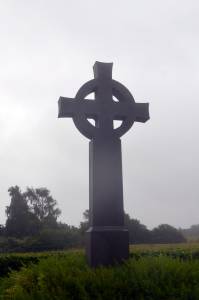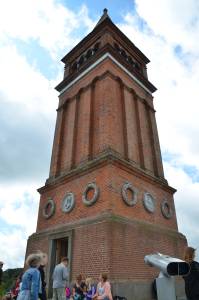A day trip into history
 Another sightseeing day. This time centered
around the town of Viborg. Our main goal of the day was Himmelbjerget, a famous
hill near Silkeborg. For many years this was believed to be the highest point in
Denmark, and not until 1847 it was discovered that it was not and that several
hills were higher. The view
from there is still great though. Along the way, and also on our way home, we
passed some historically significant places.
Another sightseeing day. This time centered
around the town of Viborg. Our main goal of the day was Himmelbjerget, a famous
hill near Silkeborg. For many years this was believed to be the highest point in
Denmark, and not until 1847 it was discovered that it was not and that several
hills were higher. The view
from there is still great though. Along the way, and also on our way home, we
passed some historically significant places.
The first was just south of Viborg. In my previous article I told that King Erik V Klipping is buried underneath the floor of Viborg Cathedral. Enroute to Viborg on 22nd of November 1286 the king and his escort got lost, and were led by a traitor among them into a barn in the small village of Finderup. Here the king was attacked and killed by men representing some noblemen, who were not satisfied with his reign. The king was killed by 56 stabs of a knife. The body was transported to Viborg and buried in the cathedral. Nine noblemen were caught and had to stand trial, and while only one were convicted for the actual murder, the remaining eight were convicted for the planning. All lost their property and were outlawed. Today it is believed that not all if any of the men convicted were actually involved in the killing. Accused of leading the attack, was Stig Andersen Hvide, the kings leading general and minister of war. Today a cross is raised where the barn was, and that was what we wanted to see.
Finderup is 10 kilometers (km), that is 6 miles south west of Viborg, and 15 minutes after leaving our hotel, we were there. We found the cross easy enough, and even if it was rainy and misty we took some pictures. We have later learned this was probably not the place of the murder anyway, as archeologists now believe that the barn was, where todays church is, and where the cross has been raised was a small chapel at the time of the murder. From Finderup we headed south east to a manor called Hald Hovedgaard. Not to visit the manor but to enjoy the view of Hald Sø (Hald Lake), which were supposed to be very beautiful, and so it was. The lake and the manor are situated in an area called Dollerup Bakker (Dollerup Hills), and we spent some time there looking at the lake and the hills, before continuing 21 km (13 miles) further south to a place called Grathe Hede. Grathe is an old word for gray, so actually it means Gray Heath. Today there is not much heath left, as most of the area has been cultivated. This is another historic site though.
On a lonely field behind a farm house, you find a pillar. To get to it, you have to take a small road that leads through the yard of the farm house. This pillar indicated the spo
rt, where King Svend (Sweyn) III was
killed in 1157 (a lot of dead kings in this article). Three kings were competing
for the title of monarch of all of Denmark. Canute V, Sweyn III and Valdemar I) (later
known as The Great) were all related and all was decendants of former kings, and
when King Erik III abdicated in 1146, the kingdom was divided between the three
contestants. Each of them wanted the whole kingdom for himself though. In 1157 a feast was held in Roskilde,
with the purpose of uniting the three kings, but Sweyn ordered
his men to kill Canute and Valdemar. Canute was killed but Valdemar
escaped and on the 23rd of November the two kings met, each
 with an army on
Grathe Hede. Valdemar won the battle, and Sweyn escaped and later surrendered to
a peasant, who in stead of accepting the surrender, killed the king with an axe
because the king had raped his wife on the night before
the battle. When we had photographed the pillar and looked at the wheatfield
surrounding it, we returned to the main road, where we parked the car. From the
parking lot, we walked to a place called Kong Knaps Dige (King Knap's Ditch)
where the actual battle took place. Nobody know who King Knap was, but the
ditch has been dated back between 100 and 1000. A rather large time span, but it
has probably been rebuilt a few times. It
has probably served as a border between different tribes.
with an army on
Grathe Hede. Valdemar won the battle, and Sweyn escaped and later surrendered to
a peasant, who in stead of accepting the surrender, killed the king with an axe
because the king had raped his wife on the night before
the battle. When we had photographed the pillar and looked at the wheatfield
surrounding it, we returned to the main road, where we parked the car. From the
parking lot, we walked to a place called Kong Knaps Dige (King Knap's Ditch)
where the actual battle took place. Nobody know who King Knap was, but the
ditch has been dated back between 100 and 1000. A rather large time span, but it
has probably been rebuilt a few times. It
has probably served as a border between different tribes.
On the way to the ditch we walked along a part of Hærvejen eller Oksevejen, som den også kaldes (the army road or the ox road), a very old road, dating back hundreds if not thousands of years. We admired the landscape and the ditch and Haller Å (Haller Creek) in front of the ditch, before returning to the car. We continued to our main goal, Himmelbjerget. Himmelbjerget is a hill outside Silkeborg, on the banks of Julsø (Jul Lake). The hill is 482 feet high, and raises steep from the lake, but not so steep on the other side, where you can drive almost to the top. The view over the lake is terrific, espcially on a clear day, which unfortunately this was not. On the top of the hill is a tower, but we didn't climb the stairs. We don't like to pay to climb stairs. Near the top are erected memorials of famous Danes like the poet Steen Steensen Blicher, author Leopold Budde and others. Small boats are ferrying passengers from Silkeborg to Himmelbjerget. One of them is Hjejlen, built in 1861, and the oldest paddle steamer in the world still using the original steam engine. Hjejlen had just left and were heading back to Silkeborg, so we stood and watched it until it disappeared in the distance.
After our visit to Himmelbjerget we headed northeast to Tangeværket, the first Danish hydroelectric powerplant, which are still in use but also serves as a museum of electrical power. Along the way we passed through Grønbæk, a very small village. Here you can visit the ruins (actually only the foundations are left) of Erik Klipping's Hunting Cabin, where he and his escort slept the night before the fatal ride to Finderup. So of course we made a stop here to visit the place. There was not much to see, so we returned to the car and continued north east. Tangeværket, next to Tange Sø, was built in 1921. The lake is artificial, made from damming the River Gudenå. The powerplant is still in use, producing around 11 MWh a year from it's 3 double Francis Turbines. Besides the powerplant itself, one of the buildings is working as a power museum. The museum also has another bulding housing a high voltage laboratory where things like creation of lightning and sparks of several million volts are demonstrated to the audience. The same building houses a Van der Graf generator, originally used by Nobel Prize winner Niels Bohr and used as a particle accellerator on the Niels Bohr Institute in Copenhagen. We spent a couple of hours looking at the place before we continued.
When
we had grown tired of the museum, we turned north east heading for Viborg, but as it
was still only afternoon we decided to make another historical call before going
back to the hotel. We therefore drove 67 km (41 miles) north from Tange Sø to another
body of
 water, called Lovns Bredning, part of Limfjorden, which we
had crossed the
previous day. In a very small village is another museum, called
Stenaldercenteret or The Stone Age Center. This small village is called
Ertebølle, and it has given its name to a whole culture, namely the Ertebølle
Culture (lasting between 5300 and 3900 BC). The culture is know for its kitchen
middens. We looked at the museum and then walked around the outside area, where
two modern day flint smiths were working, making daggers of flint, using only the
tools that were used in the stone age, but wearing modern day clothing and
leather gloves. When we were done here we tried to locate a small circular
rampart nearby, but with no luck. Back home I learned that it is only 30 feet
across, so we may simply have overlooked it. In stead we visited a rather special
bronze age mound called Myrhøj. Acutally it's a ordinary bronze age mound, but
is special because a circle of small stones are surrounding it, and a row of
stones are leading away from the mound in a more than 500 feet straight line.
water, called Lovns Bredning, part of Limfjorden, which we
had crossed the
previous day. In a very small village is another museum, called
Stenaldercenteret or The Stone Age Center. This small village is called
Ertebølle, and it has given its name to a whole culture, namely the Ertebølle
Culture (lasting between 5300 and 3900 BC). The culture is know for its kitchen
middens. We looked at the museum and then walked around the outside area, where
two modern day flint smiths were working, making daggers of flint, using only the
tools that were used in the stone age, but wearing modern day clothing and
leather gloves. When we were done here we tried to locate a small circular
rampart nearby, but with no luck. Back home I learned that it is only 30 feet
across, so we may simply have overlooked it. In stead we visited a rather special
bronze age mound called Myrhøj. Acutally it's a ordinary bronze age mound, but
is special because a circle of small stones are surrounding it, and a row of
stones are leading away from the mound in a more than 500 feet straight line.
After our visit to Myrhøj we returned to Viborg and after some difficulties found a place to eat. The place, where we wanted to eat wase closed, the next places had an hour and a half waiting line and the Chinese Buffet restaurant were out of buffet! Finally we had to settle for Jensens Bøfhus, a Danish chain restaurant serving mostly steaks (bøf meaning steak, so Jensens Steak House). The food waw ok, but not actually what we were looking for. Anyway, we weren't hungry when we left to finally return to the hotel.